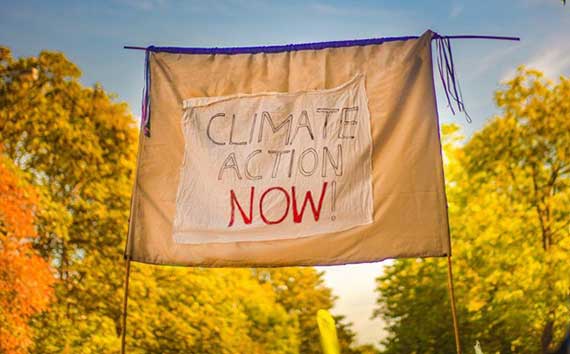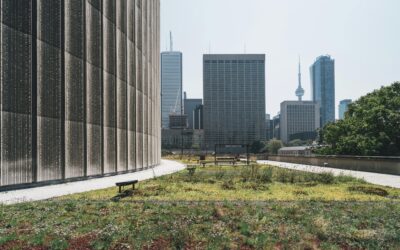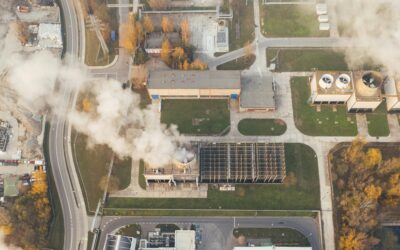But the point of reading articles like this is not to despair but to inform yourself and then figure out what you can do to help. So before reading on, remember it’s the actions we take individually and collectively that matter, and when we take action, there is always hope.
Now, let’s look at what the biggest U.K. environmental issues are, examine what is being done about them, and how you can help.
What Is the Biggest Environmental Issue Today?
 source
source
The answer to this question can initially appear straightforward. The biggest threat that we face arises from the burning of fossil fuels.
Carbon and other greenhouse gas (GHG) emissions, and the race to net-zero emissions, have become synonymous with counteracting climate change. This is largely because these emissions are measurable and relatively easy to productise (in the form of carbon offsets, for example). Emissions must be brought down to sustainable levels in order for us to avoid runaway global warming and the knock-on impacts on our climate.
However, the attention on carbon has led to an overly narrow focus on greenhouse gas emissions and reducing carbon footprints. Climate change is about all threats to our ecosystems as well as the human and animal systems that rely on them.The environmental issues contributing to climate change are complex because our environment — the interconnected system of all life on this planet — is complex.
For example, when a forest is cut down to make way for agricultural land, emissions are released, and a valuable source of carbon absorption going forward is lost. It also leads to habitat destruction and biodiversity loss, soil degradation, displacement of local communities, and so on.
Therefore, it is not really possible to speak of one threat in isolation from another. First, because they are all interrelated. And second, because each issue presents a different sort of threat to our ecosystems. Even where it is possible to analyse something like soil quality with numerical data, the numbers cannot be readily compared between carbon emissions and nutrients in soils.
What Are the 5 Major Environmental Issues?
As environmental issues have become more advanced, so too has our understanding of the problem.
This has led to a consensus amongst climate experts that the only real way to understand climate change is through adopting a holistic ‘systems’ lens. Thanks to groundbreaking books such as Doughnut economics, there is a growing understanding that all of the problems we face are interrelated, mutually reinforcing, and ultimately inseparable — not only from one another but also from the systems of industry and governance that support them.
Here are five main environmental issues, all of which interconnect.
1. Air Pollution
As long ago as Charles Dickens’ stories of life in London in the industrial age, industry has had a noticeable effect on the quality of our air. While we think of this as a bygone era, air quality has plummeted in urban and industrial centres consistently since the burning of fossil fuels at the start of the industrial age.
This is a real public health risk in the present day. In London, 2 million people reside in heavily polluted areas. In some areas, air quality is so bad that living there equates to smoking 159 cigarettes a year.
Whereas in the past these emissions would have come largely from industry, now it is due to transport, such as car traffic and air travel. Still, when we combine air pollution caused by emissions from transport and industry, it is responsible for as much as 10% of deaths in the U.K., killing as many as 29,000 people a year.
We can also see how air pollution leads to climate change more generally. Greater pollution is caused by increased emissions (as well as harmful aerosols), which create more warming, leading to wildfires, deforestation and soil degradation as well as rising sea levels.
2. Soil Pollution
The need to feed a global population that is constantly on the rise (and set to reach around 11 billion by 2100) is putting enormous strain on our systems of production.
All food comes from the earth (even animals are reared on feed from crops). For this reason, organisations such as the Soil Association identify soil quality as critical to defend in order to ensure a healthy planet.
Soil quality is in decline globally, primarily because of industrial farming techniques and deforestation. Industrial farming typically grows crops in monocultures (i.e., when one crop is grown in isolation), uses toxic pesticides and fertilisers, and generally degrades soil quality through overuse.
As the soil quality depletes, this requires the use of more chemical fertilisers, compounding the depletion of the soil over time. And monocultures drastically limit biodiversity (which we will look at below). It is easy to see how many more animals can exist in a rainforest habitat compared to an endless field of almond trees.
Although associated especially with the U.S. and Latin America, factory farming is on the rise in the U.K., rising by 7% between 2017 to 2020 to 1,786 industrial farms.
Soil quality globally and in the U.K. is also affected by landfills and poor waste management generally, as toxins seep into the ground.
Water Pollution
We cannot speak meaningfully of air and soil pollution without mentioning water pollution, because they are all intimately interrelated. Chemicals run down from degraded soil into the water system, leading to ocean acidification and acid rain and affecting the quality of our drinking water.
3. Deforestation
In terms of the U.K., deforestation is the outlier in our list. Forest cover in the U.K. is actually on the rise and is currently around the 15% land cover that it was at the time of the Doomsday Book nearly 1,000 years ago.
However, this raises an important point. Where the U.K. has been able to increase its own forestry cover, this is largely as a result of displacing many of its land-intensive needs overseas . The main reason for deforestation is to clear land for food production — principally, cattle grazing and/or feedstock for cattle. (It also happens frequently to clear land for palm oil plantations and, of course, for wood.)
If we are thinking systemically therefore, deforestation has to be included in the environmental issues facing the U.K. Climate change is a global event, and harmful activities which are moved abroad do not simply disappear.
Perhaps the most powerful and frightening images relating to climate change are the pictures of the earth that show the extent of deforestation. The Amazon, for example, known as the lungs of the earth for its ability to regulate the air we breathe, has been decimated. This is visible in large scars of brown riven into the earth’s surface. (We lose one football pitch’s worth of the Amazon every minute.)
Deforestation leads directly to heatwaves, as the land becomes more arid, leading to wildfires which create further deforestation. Here we see, as in so many issues relating to climate, a negative feedback loop. Deforestation occurs, leading to increased emissions, leading to temperature rise, leading to more deforestation (as well as to melting ice caps, rising sea levels and so forth).
Deforestation also depletes soil quality by exposing the bare earth to the sun where before there was tree cover and by robbing the soil of the nutrients trees provide through their roots.
4. Species Extinction and Biodiversity Loss
For many, although tragic, species extinction is a consequence of climate change, not a cause. But it is in fact both. The more biodiversity we lose, the less resilient our ecosystems become. The more habitats we lose, such as peat bogs and forests, the more emissions are released.
Biodiversity is essential to the planet’s resilience. When a system is not diverse, it becomes vulnerable because it has less alternatives available if things go wrong. (You can think of something like the potato famine, where there was only one crop that the Irish were allowed to eat, so when it failed, it was catastrophic).
As such, we see another negative feedback loop. As biodiversity reduces, systems become less resilient and able to adapt to a changing climate, resulting in further biodiversity loss.
Biodiversity loss has accelerated exponentially during the anthropocene (the era during which humans have come to be the primary influence on our planet’s climate systems, as opposed to natural processes). As habitats continue to be placed under threat by human expansion, extinction is occurring at an unprecedented rate.
We are currently losing between 17,000 and 100,000 species per year, and an incredible ‘one-quarter of the world’s mammals; 1-in-7 bird species; and 40% of amphibians are threatened,’ according to Our World in Data. This has been referred to as the Sixth Great Extinction, the last of which occurred 65.5 million years ago.
In the U.K., species extinction is brought about primarily as a result of litter entering the seas, with the Marine Conservation Institute reporting, ‘The rate at which we’re losing species is 100, maybe even 1,000 times the normal rate.’
Maritime and coastal habitats are under threat generally, particularly as a result of erosion along coastlines (from rising sea levels and more extreme weather events) as well as overfishing. Indigenous animals in the U.K. are also under threat, such as hedgehogs, whose population has declined from 36 million to 1 million since 1950. The situation is increasingly serious, with 15% of all U.K. species under threat according to a 2019 State of Nature Report.
5. Sea Level Rise and Flooding
No list of U.K environmental issues could be complete without flooding. As an island, the U.K. is at particular risk.
Floods have been occurring at an increasing rate over the past few decades, with as many as one in six homes now at risk of flooding in the U.K. The probability of flooding will increase by as much as 35% by 2080.
The increased risk can be seen by the number of people and homes affected by flooding in recent years. The figure rose from 8,000 homes and businesses in 2012 to 11,000 homes in 2013-2014 and 17,000 in 2015-2016.
Floods are caused by rising sea levels and increased rainfall, themselves caused by events such as the melting of the ice caps.
Does the U.K. Care About the Environment, and What Is the U.K. Doing in Response to These Threats?
Environmental issues have shot up the agenda in the U.K. in recent years. The U.K. government was the first government in the world to announce a climate emergency, where it commited a target of 2050 to reach net-zero emissions. However, currently, not enough is being done, with the U.K. not set to meet this target.
Even doing so would fail to take into account the U.K.’s historic environmental impact, which continues to harm the climate through emissions still in our atmosphere and so on, so it is critical that the U.K. does more than it is presently.
Still, meaningful progress has been made.
Under new legislation, all companies now have to report emissions. This increases accountability by making an organisation’s emissions publicly accessible. There are also increasingly stringent fines for companies violating environmental laws, such as how waste is disposed of, contaminating water supplies and so on.
For high-emitting organisations in heavy industry and aviation, for example, the U.K. government has also implemented its own ‘carbon cap,’ whereby an organisation has to stay within a certain emissions limit or face heavy fines.
However, this regulation has yet to extend beyond high emitters, and newly regulated industries such as the aviation sector are also awarded many carbon credits for free, essentially allowing them to continue to emit carbon while they adapt their business practices. This is seen as a necessary balancing act between business and climate concerns, but ideally, the government should implement approaches that align business priorities with those of the climate.
There has also been some support for green technologies and energy efficiency through financial incentives. However, recent governments have consistently rolled back subsidies on green technology and low-energy solutions.
More specifically, in terms of mitigating air pollution, for example, London saw the introduction of the Low Emissions Zone followed by the Ultra Low Emissions Zone (ULEZ), which expanded from the centre of London up to the North and South Circular roads in October 2021. Drivers whose vehicles do not meet certain emissions criteria have to pay a surcharge of £12.50 to drive inside this zone.
This has reduced the number of non-compliant vehicles from around 60,000 to just above 20,000. This has had tangible effects on air quality. A TFL report indicated that nitrous oxide emissions — an extremely harmful greenhouse gas — fell by 31% compared to a baseline scenario where the ULEZ had not been introduced.
However, despite such innovations, the government will also fail to meet its ‘clean air’ target for 2030 at current rates of pollution.
In terms of flooding, the U.K. spends 4.4 billion pounds a year on flood defence, which goes a long way to protecting thousands of homes. However, this is ultimately treating the symptoms of the problem rather than the cause and is an ultimately unsustainable approach as sea levels continue to rise.
The U.K. can, however, proudly claim to be a world leader in terms of investment in wind energy, which represents exactly the kind of systemic solution needed, drastically reducing our dependence on fossil fuels. The U.K. has about 10GW of capacity through wind energy as things stand and has committed to achieving 50GW by 2030, which would provide enough to power every household in the U.K.
Measures such as this have contributed to the U.K.’s emissions falling since national efforts began with the first international climate convention in 1992. However, this figure is often misleadingly reported as 40%, which does not factor in emissions outsourced to other parts of the world for the production of goods consumed in the U.K. After this adjustment, emissions have fallen by 15%.
On a closing note, it’s important to remember that it isn’t only the government that is responsible for tackling the U.K.’s environmental issues. Individuals and communities also have their part to play, and there is a powerful and growing activism and community-based movement in the U.K.
For example, the National Trust had fewer than 7,000 members in 1944, whereas in 2017, it had around 5 million. There are also now Transition Towns — community-led responses to climate change that aim to increase self-sufficiency and sustainability locally — popping up all over Britain. And according to an IPSOS Mori survey, 8% of people had been a member of an environmental group and 7% campaigned for an environmental issue.
Do Your Part to Combat U.K. Environmental Issues
No one U.K. environmental issue can be isolated from any other. This is because we share a planetary climate system and live in an interrelated world in terms of trade, travel, and governance.
In the U.K., the most pressing local concerns are air pollution and flooding. Species extinction is also happening at an alarming rate, and soil and water pollution occur locally thanks mainly to industrial practices and waste disposal.
Deforestation, although occurring abroad, cannot be divorced from climate concerns locally, due to the U.K.’s responsibility for it thanks to its consumption.
The U.K. government, whilst taking action, is not doing enough.
While the main responsibility should fall to them, you can still make a difference. Check out how Terrapass’ offset products can help you reduce your individual footprint.
Brought to you by terrapass.com
Featured image:













